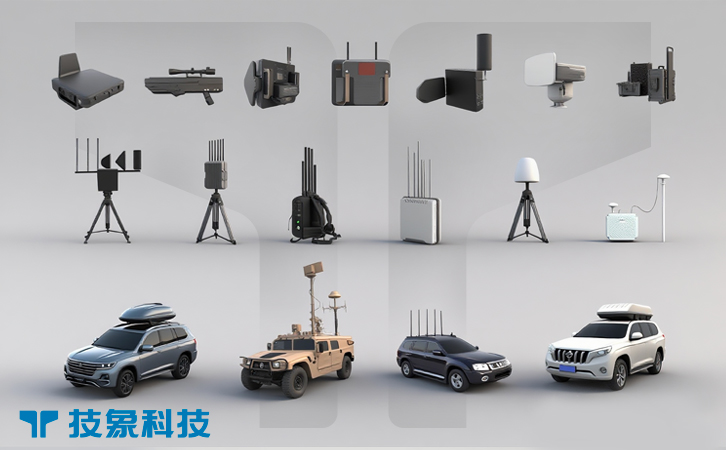The advent of drone swarms—coordinated groups of unmanned aerial vehicles (UAVs) operating in unison—has introduced unprecedented challenges to airspace security. Unlike single drones, swarms can overwhelm traditional anti-UAV defenses through sheer numbers, synchronized maneuvers, and distributed intelligence, posing threats to military bases, critical infrastructure, and public events. Countering drone swarms requires advanced technologies and innovative tactics that can detect, track, and neutralize multiple UAVs simultaneously while adapting to their dynamic behavior. This article explores the technologies and tactical approaches driving effective anti-swarm defense, detailing the tools, strategies, and future innovations shaping this critical field.
I. Understanding Drone Swarm Threats and Challenges
Drone swarms represent a paradigm shift in aerial threats due to their ability to operate as a cohesive unit, often controlled by autonomous algorithms or a single operator. These swarms, ranging from dozens to hundreds of UAVs, can perform complex tasks like reconnaissance, electronic warfare, or coordinated attacks, as demonstrated in incidents like the 2020 Nagorno-Karabakh conflict, where drone swarms were used to overwhelm defenses. Their small size, low cost, and ability to disperse across wide areas make them difficult to detect and neutralize using conventional anti-UAV systems designed for single targets.
The challenges of countering swarms are multifaceted. Traditional radar systems struggle to track numerous small targets with low radar cross-sections, especially in cluttered environments like urban areas. Radiofrequency (RF) detection is less effective against autonomous swarms that minimize communication signals, relying instead on onboard AI. Neutralizing multiple drones simultaneously requires scalable countermeasures, as engaging each UAV individually is impractical. Additionally, swarms can employ evasive tactics, such as splitting into smaller groups or mimicking natural phenomena like bird flocks, complicating classification. Understanding these threats is critical for developing technologies and tactics that can scale to address the volume and complexity of swarm-based attacks.
II. Detection and Tracking Technologies for Drone Swarms
Effective swarm defense begins with robust detection and tracking systems capable of handling multiple targets in real time. Advanced radar systems, such as 3D phased-array radars, are essential for detecting swarms at long ranges, often up to 10-20 kilometers. These radars use high-resolution beamforming to track numerous small UAVs simultaneously, distinguishing them from environmental noise or non-threatening objects. For example, the Giraffe 4A radar, used by military forces, can monitor hundreds of targets, providing a comprehensive view of swarm activity.
RF sensors complement radars by intercepting communication signals when swarms rely on centralized control. However, for autonomous swarms, electro-optical and infrared (EO/IR) systems with high-resolution cameras and thermal imaging are critical, offering visual confirmation of multiple targets. AI-driven image recognition enhances these systems by analyzing flight patterns to identify swarm behavior, such as synchronized movements. Acoustic sensors, which detect the cumulative sound of drone motors, provide short-range detection in environments where radar signals are obstructed. Multi-sensor fusion, integrated through command-and-control (C2) systems, combines data from radar, RF, EO/IR, and acoustic sensors to create a unified tracking profile, enabling precise monitoring of swarm trajectories and behaviors across diverse terrains.
III. Countermeasure Technologies for Swarm Neutralization
Neutralizing drone swarms requires scalable countermeasures capable of engaging multiple targets efficiently. Non-kinetic solutions, such as high-powered microwave (HPM) systems, are particularly effective, emitting electromagnetic pulses that disrupt the electronics of multiple drones over a wide area. For instance, the U.S. Air Force’s THOR (Tactical High-Power Operational Responder) can disable swarms within a kilometer radius, offering a rapid, broad-area defense. RF jamming remains viable for swarms reliant on communication links, with advanced jammers dynamically targeting multiple frequencies to disrupt coordination without affecting nearby systems.
Kinetic countermeasures, like laser systems, are evolving to address swarms. High-energy lasers, such as Raytheon’s HELWS (High-Energy Laser Weapon System), can engage multiple drones sequentially by focusing precise beams to burn through critical components. However, their effectiveness is limited by power requirements and line-of-sight constraints. Emerging technologies, like drone-mounted net-launchers or counter-swarms, deploy UAVs to physically intercept rogue drones, capturing them for analysis. These systems are supported by AI-driven targeting algorithms that prioritize high-threat drones within a swarm. The integration of kinetic and non-kinetic countermeasures, controlled through automated C2 platforms, ensures rapid and scalable neutralization, minimizing the risk of swarm penetration.
IV. Tactical Approaches to Swarm Defense
Tactical strategies for countering drone swarms emphasize layered defense, adaptability, and coordination. A layered approach deploys multiple detection and countermeasure systems to create overlapping zones of protection. For example, long-range radars provide early warnings, while short-range EO/IR systems and jammers handle close-in threats. This strategy, used in systems like the U.S. Army’s M-LIDS (Mobile-Low, Slow, Small Unmanned Aircraft Integrated Defeat System), ensures comprehensive coverage against swarms approaching from different altitudes or directions.
Adaptability is critical, as swarms can change tactics mid-operation, such as dispersing to evade detection. AI-driven predictive models analyze swarm behavior in real time, enabling dynamic countermeasure adjustments, such as redirecting HPM pulses or prioritizing laser targets. Coordination with broader defense networks, including air traffic control or missile defense systems, enhances situational awareness, particularly for protecting large areas like airports or military bases. Training programs are essential, equipping operators with skills to manage complex C2 interfaces and respond to swarm-specific threats. Tactics also include deception, such as deploying decoy signals to mislead swarms, and proactive measures, like intercepting command signals to trace operators. These strategies, combined with advanced technologies, create a resilient defense against swarm attacks.
Conclusion
Countering drone swarms demands a sophisticated blend of technologies and tactics tailored to their unique challenges. Advanced detection systems, scalable countermeasures like HPM and lasers, and adaptive tactical approaches form the backbone of effective swarm defense. As drone swarms become more autonomous and coordinated, innovations in AI, multi-sensor fusion, and networked defenses will be critical to staying ahead of the threat. By integrating layered detection, rapid neutralization, and dynamic tactics, anti-UAV systems can protect critical assets and public safety, ensuring resilience in an era where swarm technology redefines aerial security challenges.



